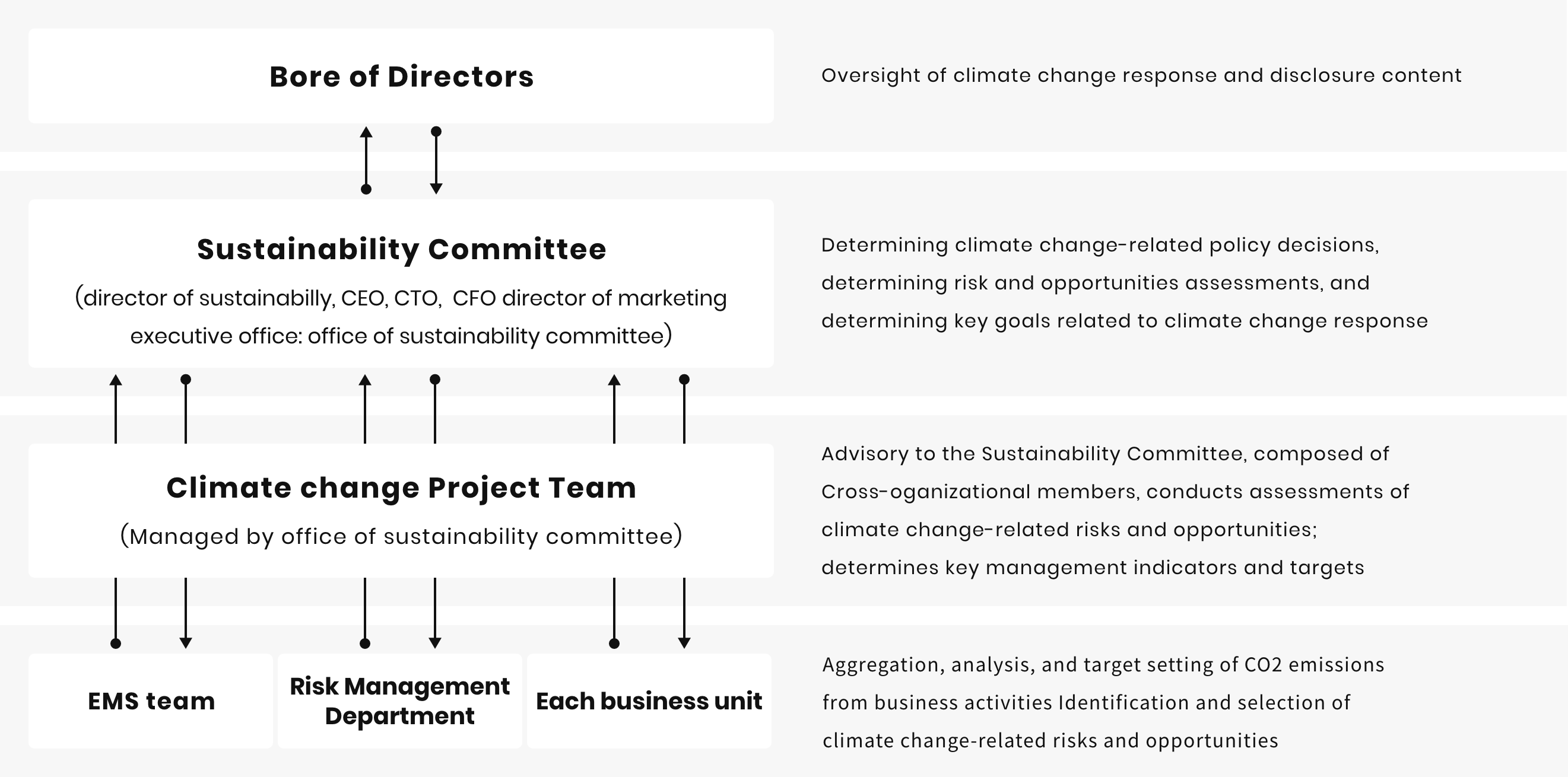Sustainability: Environmental initiatives
Climate change response
Related goals
Climate change response
In order to contribute to achieving the goals of the Paris Agreement on climate change, an international framework, we have set our own goals to address climate change and will actively take initiatives to reduce greenhouse gas emissions through our business.
In addition to reducing direct greenhouse gas emissions from our own activities, we will achieve this by providing a wide range of services that contribute to reducing environmental impact through our proprietary technologies, thereby increasing the effectiveness of reducing greenhouse gas emissions in society as a whole.
Indicators and Targets
We have selected greenhouse gas (GHG) emissions as a measure of climate change and disclose our performance for Scope 1-3 of the GHG Protocol. In addition, we have set the following goals to reduce risks and create new opportunities for climate change:
- Scope1&2Reduce GHG emissions to 0 by 2030
- For Scope 1 & 2, reduce GHG emissions from in-house operations to zero (net) by converting 100% of electricity consumption to renewable energy.
- Scope3Reduce GHG emissions to 0 by 2030
- Reduce indirect GHG emissions from Scope 3 business activities to zero (net) by contributing to the reduction of environmental impact through the provision of our products and services.
| GHG emissions results | Unit | 2021 | 2022 | 2023 | |
|---|---|---|---|---|---|
| SCOPE1 | Direct GHG emissions | t-co2 | 6 | 8 | 11 |
| SCOPE2 | Indirect GHG emissions | t-co2 | 1,232 | 873 | 676 |
| SCOPE3 | Indirect GHG emissions | t-co2 | 3,734 | 5,297 | 8,664 |
| Total emissions | t-co2 | 4,973 | 6,178 | 9,351 | |
| Scope 3 breakdown: | |||||
| Category 1: Products and services purchased | t-co2 | 3,071 | 4,541 | 5,580 | |
| Category 2: Capital finance | t-co2 | 364 | 93 | 1,980 | |
| Category 3: Activities related to fuel and energy that are not included in Scope 1 and 2 | t-co2 | - | - | 101 | |
| Category 5: Waste from business operations | t-co2 | 0 | 0 | 0 | |
| Category 6: Business trips | t-co2 | 130 | 455 | 771 | |
| Category 7: Employer commuting | t-co2 | 169 | 208 | 232 | |
| Intensity | CO2 emissions per sale | tons of CO2e/one million yen | 0.26 | 0.28 | 0.37 |
※Each item is the actual results of WingArc1st (non-consolidated).
Governance structure
We have established the Sustainability Promotion Committee as an organization to evaluate and monitor our policies and initiatives to achieve our climate change-related goals. The CEO and other members of management are involved in the development of climate change strategies and report their efforts to the Board of Directors.

- Board of Directors
- Oversight of climate change response and disclosure content
- Sustainability Committee (director of sustainability, CEO, CTO, CFO, director of marketing, executive office: office of sustainability committee)
- Determining climate change-related policy decisions, determining risk and opportunities assessments, and determining key goals related to climate change response
- Climate Change Project Team (managed by office of sustainability committee)
- Advisory to the Sustainability Committee, composed of cross-organizational members.
Conducts assessments of climate change-related risks and opportunities; determines key management indicators and targets - EMS team, Risk Management Department, Each business unit
- Aggregation, analysis, and target setting of CO2 emissions from business activities.
Identification and selection of climate change-related risks and opportunities.
Strategy
The risks and opportunities we face in relation to climate change were assessed by the relevant departments and the Sustainability Promotion Committee for the timing of their manifestation and their impact on our business, and then we identified risks and opportunities of particular importance.
We recognize the following as important transition and physical risks and opportunities related to climate change:
| Type of risks/opportunities | Time of manifestation | Probability of manifestation | Impact on business | Response policy | ||
|---|---|---|---|---|---|---|
| Transition risks | Policy and regulations risks | Introduction of carbon pricing | Short | Low | Scope 2 is scheduled to be 100% renewable by 2030. There is no risk of applying the carbon tax. |
|
| Technical risks | Delays in developing solutions that contribute to GHG emissions reductions | Mid | Med |
Decrease in product value and corporate value due to inability to contribute to GHG emissions reduction:
|
|
|
| Market risks | Lost sales opportunities due to lack of solutions that contribute to GHG emission reductions | Mid | Med |
Loss of sales opportunities for products and services:
|
|
|
| Reputation risks | Lack of information disclosure, resulting in loss of trust from customers, society, financial institutions, and investors | Short | Med |
Decline in external evaluation:
|
|
|
| Physical risks | Acute risks |
Damage to business locations due to wind and flood damage:
|
Short | Low |
Suspension of operation of a business location:
|
|
|
Damage to supply chain due to wind and flood damage:
|
Short | Low |
Stagnation of business, including data center servers and mailing:
|
|
||
| Chronic risks |
|
Mid | Med |
Suspension of operations of business locations and data centers:
|
|
|
| Spread of diseases, including infectious diseases | Mid | Med |
Stagnation of business operations due to health hazards to employees:
|
|
||
| Opportunities | Energy conservation | Use of renewable energy | Mid | Low |
Lower procurement costs
|
|
| Products & services | Increased demand for products and solution services that contribute to GHG emissions reduction | Mid | Med |
By providing products and solution services that contribute to GHG emission reductions
|
|
|
| Market | Enhance corporate reputation through appropriate disclosure of climate-related information | Mid | Med |
|
|
|
Risk Management
Regarding our risks and opportunities in climate change, the office of the sustainability committee conducts an annual company-wide risk identification with the relevant departments.
The policy for responding to the selected important risks is reviewed on an annual basis by the office of the sustainability committee and relevant departments and is identified after discussion by the Sustainability Committee, which includes the management team.
The results of the above risk assessment are then reported by the office of the sustainability committee to the risk management department, which is responsible for company-wide risks, and to the risk and compliance committee.
- 1 The office of the sustainability committee identifies risks and opportunities related to climate change with relevant departments
- 2 The office of the sustainability committee selects important risks with the relevant departments, and reviews the policies
- 3 The Sustainability Committee discusses and identifies risks and response policies
- 4 The office of sustainability committee reports the results to the risk management department, which oversees company-wide risks, and to the risk and compliance committee.
Visualizing GHG through the power of data
WingArc1st visualizes GHG to respond to the climate crisis and aims to contribute to the decarbonization of society as a whole through the power of data.

